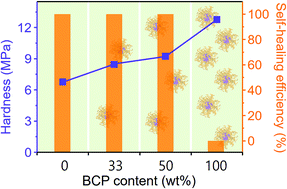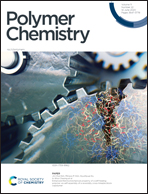Enhanced thermomechanical property of a self-healing polymer via self-assembly of a reversibly cross-linkable block copolymer†
Abstract
We report the preparation and thermomechanical properties of hetero-nanostructured self-healing polymers (HSPs) bearing a hindered urea bond (HUB) by varying the content of a self-healable block copolymer (BCP). The micellar morphology of the BCP blend in a matrix polymer was studied using transmission electron microscopy and grazing-incidence small-angle X-ray scattering with various organic solvent types and BCP contents. The self-healing efficiency of the HSPs was obtained from single-scratch tests through optical microscopy and atomic force microscopy. To confirm self-healing at the molecular level, the mechanical properties of the cross-cut and healed HSPs were also analyzed using a universal testing machine. Thermomechanical properties associated with HUB were measured by dynamic mechanical analysis and temperature-oscillating rheometry. The results showed that blending the BCP improved the toughness, the hardness, and the modulus up to 21.7, 25.3, and 24.8%, respectively. Moreover, at high temperatures, the temperature range of the rubbery plateau was greatly widened without a noticeable decrease in the self-healing capability.



 Please wait while we load your content...
Please wait while we load your content...